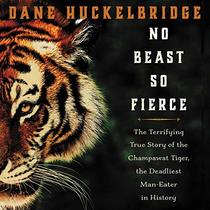Part social history, part natural history, part conservation treatise, part detective story, No Beast So Fierce is a comprehensive description of the reign of terror one tigress had over sections of Nepal and India at the turn of the twentieth century. I had come across mentions of the Champawat Tiger several times in my reading, and since my reading was in fiction, I wasn't aware that this tigress was real. When I stumbled across Huckelbridge's book, I knew I had to read it, especially since tigers are one of my two favorite big cats.
One of the most important things Huckelbridge did for me in his book was to give me a much greater respect for tigers. I knew they were marvelous creatures but didn't really understand just how wonderful they are. A tiger is "nature's nearest equivalent to a short-range missile," and to put what the Champawat Tiger did into perspective, she "very nearly consumed the entire NBA."
Hearing this, many people would want nothing more than to kill the tigress and put an end to the whole thing. Done and dusted. No more thought required. The second important thing Huckelbridge does in No Beast So Fierce is to prove that the Champawat Tiger was an entirely man-made disaster. Through many thoughtless government decisions, the tigress's killing field was created, and for anyone interested in the natural world, it is fascinating to read how this was done.
The third important thing that Huckelbridge did was to bring Jim Corbett to my attention. The final scenes where he and the Champawat Tiger meet are extremely tense and almost gave me the impression that I'd fallen into a thriller, and although his success meant that Corbett became the Go-To man for tracking and killing man-eaters, fate had much more in store for him. Corbett wasn't just a killer. In fact, he became one of the stalwarts of the conservation effort to save the Royal Bengal tiger.
If you love wildlife and want to immerse yourself in an engrossing piece of history, I suggest reading No Beast So Fierce. It's an eye-opener and proves once again that if some species of wildlife becomes a "problem" we humans need to look to ourselves to see what we did to create it.
One of the most important things Huckelbridge did for me in his book was to give me a much greater respect for tigers. I knew they were marvelous creatures but didn't really understand just how wonderful they are. A tiger is "nature's nearest equivalent to a short-range missile," and to put what the Champawat Tiger did into perspective, she "very nearly consumed the entire NBA."
Hearing this, many people would want nothing more than to kill the tigress and put an end to the whole thing. Done and dusted. No more thought required. The second important thing Huckelbridge does in No Beast So Fierce is to prove that the Champawat Tiger was an entirely man-made disaster. Through many thoughtless government decisions, the tigress's killing field was created, and for anyone interested in the natural world, it is fascinating to read how this was done.
The third important thing that Huckelbridge did was to bring Jim Corbett to my attention. The final scenes where he and the Champawat Tiger meet are extremely tense and almost gave me the impression that I'd fallen into a thriller, and although his success meant that Corbett became the Go-To man for tracking and killing man-eaters, fate had much more in store for him. Corbett wasn't just a killer. In fact, he became one of the stalwarts of the conservation effort to save the Royal Bengal tiger.
If you love wildlife and want to immerse yourself in an engrossing piece of history, I suggest reading No Beast So Fierce. It's an eye-opener and proves once again that if some species of wildlife becomes a "problem" we humans need to look to ourselves to see what we did to create it.




